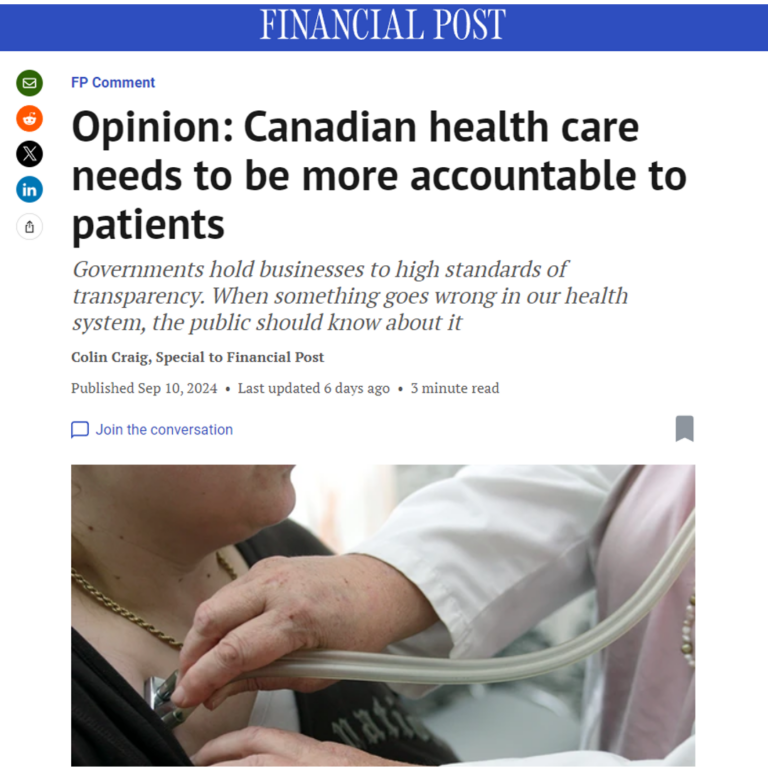FINANCIAL POST COLUMN: Canadian health care needs to be more accountable to patients

We need more accountability in health care in Canada. Across the country, Canadians pay big tax bills each year to governments that too often fail to provide quality health care in a timely manner. But not only are services often lacking, governments regularly get away without disclosing serious breaches.
Consider B.C. patient Allison Ducluzeau’s story. In late 2022, she started to feel sharp, persistent abdominal pains. After a visit with her family doctor, a trip to the emergency room and testing, she was diagnosed with late-stage cancer and was told she had anywhere from two months to two years to live. The government refused to provide her with potentially life-saving surgery, which it claimed wouldn’t help. It did, however, suggest assisted suicide as an option.
Ducluzeau couldn’t bear the thought of her children, who are in their 20s, losing their mother at such a young age. After difficult conversations with family members about her situation, she decided to dig a little deeper and not give up. Allison and her family spoke with clinics as far away as Taiwan to find a treatment. Four different health providers told her she was actually a good candidate for surgery — the same surgery the B.C. government refused to provide. Ducluzeau eventually decided on Mercy Medical Center in Baltimore and paid the $200,000 bill out of a small inheritance, by cashing in savings and with funds raised through GoFundMe.
A year and a half later, Ducluzeau is in remission. Not only is she back at work full time, she goes paddle-boarding regularly and has even started running again. She is quite happy she did not take up B.C. health care’s offer of assisted suicide.
What is the B.C. government doing about this debacle? Apparently, nothing. Ducluzeau has sought reimbursement for at least part of her surgical costs, but the government has so far refused. It has been pleased to take thousands of dollars a year from her in taxes all her working life, but is not so keen to pay at least a portion of the bill for its mistake. That should obviously change.
It’s a sad fact that Ducluzeau’s story is far from unique. The same clinic she visited in Baltimore informed SecondStreet.org they have treated many other Canadian patients over the years. One was Lorne Johnson from Ontario, who travelled to the clinic recently because of long wait times at home. Considering that an Ontario court recently ruled that Ontario Health had to cover the cost for an unnamed male patient to travel to Texas to have an artificial vagina added behind his penis, it will be interesting to see if Johnson’s bills for a medically necessary procedure will be covered … but one digresses.
Needless to say, countless other horror stories from Canada’s health-care system don’t get reported on publicly. Data gathered by SecondStreet.org from health bodies nation-wide shows that at least 17,296 patients died in 2022-23 while waiting for a wide array of surgeries and diagnostic scans. How many could have received life-saving treatment had they got faster care? With the exception of Nova Scotia, governments seldom provide a breakdown.
We know about Ducluzeau’s story, not because governments admitted their error, but because she spoke with media about her experience. But media can only cover so many stories and not everyone wants their name splashed across the news. If governments want to improve accountability in the health care sector, they could require health departments to be more upfront when mistakes are made.
Provincial governments often require businesses to file reports when employees receive so much as a bruise during a workplace accident. Often these reports are made public. Why not require governments to disclose, with privacy suitably protected, when patients die waiting for lifesaving treatment, have near misses with death or end up with permanent health problems because of long waits?
Governments are fine setting the transparency bar high for businesses; they should have to meet just as high a bar themselves. And while they’re are at it, they need to be financially accountable when serious breaches are made. In B.C.’s case, they could start by contacting Allison Ducluzeau about her costs.
Colin Craig is the president of the think tank SecondStreet.org.
This column was originally published in The Financial Post on September 10, 2024.
You can help us continue to research and tell stories about this issue by making a donation or sharing this content with your friends. Be sure to sign up for our updates too!


